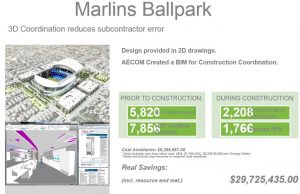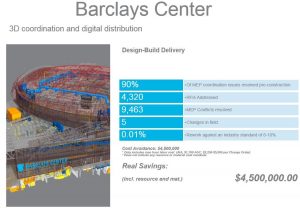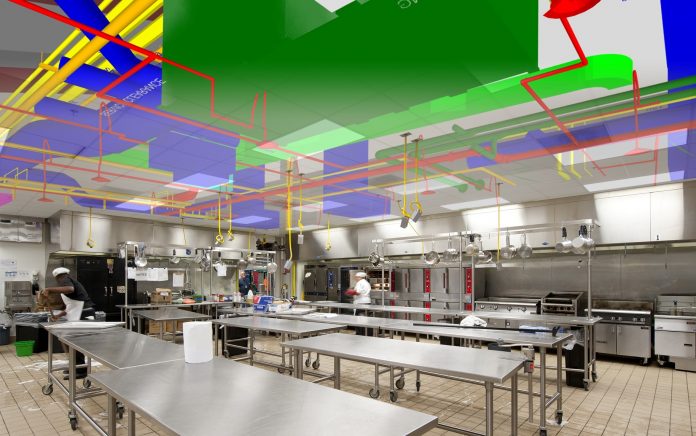Russ Dalton, AECOM’s BIM director for the Americas, traces the development of technology behind some high-profile sporting projects, including the Barclays Center and Marlins Ballpark
Given the rapid pace of technology development and change across the globe, it isn’t really surprising that the digital tools we use in the architecture, engineering and construction (AEC) industry have also evolved rapidly. Yet, when I reflect on the evolution of building information modelling in my career of nearly 35 years, the pace of transformative change is quite extraordinary.
Remember when modelling was conducted using large mainframe computer graphics systems by placing intelligent objects into the design file? Maybe you don’t. But that’s where my story begins with the use of two separate modelling modules: AMOD (ArchitecturalModeling) and APDP (Architectural Production Drafting Package). The combination of these two modules allowed you the ability to create mass models and transfer into construction documents.
The other system that played a pivotal role in my journey was the Overlay Drafting System, which focused on supporting an accelerated practice of 2D collaboration between disciplines. This proved to increase communication and profitability of our projects as it decreased risk due to clash detection errors in that all disciplines were working from the same footprint. By today’s standards this seems archaic, but at the time, the integration of the two methods created a foundation and best practices for BIM adoption.
Using design and build technologies
Ten years ago, the opportunity came to join the largest sports contractor in the United States. AECOM Hunt offered me the position to develop a BIM program for their design/build programme. My first project was the Marlins Ballpark in south Florida. This was designed in 2D, but we needed to generate the 3D BIM from the 2D construction documents. A most critical element of the project was building the $515m retractable roof stadium with LEED status. We used the BIM to track our points and earned the first LEED Gold rating for a stadium.
At that time the technology stack we used was Revit, Civil 3D, NavisWorks and Buzzsaw. This technology stack, along with processes I’d identified and refined for collaboration and geometric certainty served as a highly successful benchmark that was attributed to the fledgling BIM program, resulting in a savings for the client of over $29.7m (see chart 1).

One year later, we launched a complete AECOM Hunt design build project in Brooklyn, New York, for the Brooklyn Nets. This arena was a $450m arena in the heart of Brooklyn with close proximity to the Brooklyn Bridge and an active subway line. We executed using a similar technology stack for this project with the addition of BIM 360 Field for QA/QC, collaboration and an accelerated approach of communications between field, design and fabrication shops. Our “better” approach delivered the net results we were aiming for and produced incredible savings for the client of $4.5m (see chart 2).

The results were outstanding and positioned AECOM at the head of the class. However, as the technology world turns, so does AECOM in its adoption of BIM best practices and technologies. While we achieved geometric certainty for design and building, our focus increasingly became cost certainty.
The “best” technology stack
At this point, AECOM entered into the next stage of sports builds with our “best” technology stack. While we continue to use BIM as our standard practice, our focus has shifted. We are currently underway in design and build on two major sports facilities in California, where we are using the “best” modelling technology to gauge not only geometric certainty but cost certainty.
Our commitment to the use of modelling now brings cost-effective design and build to every client we serve. BIM is always our foundation – an invaluable cost- and time-saving tool. Our BIM foundation, along with an evolving technology stack, ensures we continue to transform how projects are planned, built and maintained.
Leveraging BIM
We view every aspect of the job, from design to turnover, through the use of advanced 3D modelling, clash detection, cost certainty and scheduling. Based on our LOD (level of development for BIM) standards, AECOM takes the process one step further with the utilisation of a full project delivery system (PDS). Upon completion, a detailed building management model can be made available to the client. This PDS tool greatly reduces building management overhead and helps ensure the proper maintenance of every aspect of the facility.
We leverage the power of BIM during design for LEED, Net Zero directives and energy analysis, to name a few. Further, we analyse the sight lines and temperature controls to ensure that the spectator experience exceeds expectation. AECOM believes that BIM-driven projects are more strategically planned, allowing for optimised collaboration, productivity, scheduling and profitability.
3D, 4D and 5D modelling
With BIM, the AECOM team cost-effectively builds the project twice – once virtually and the second time physically. We utilise modelling in the design phase, which is continually updated with 3D, 4D and 5D information and shared with all members of the design/construction team.
The 4D model is a process of linking the project schedule line items to the 3D model. This process enables us to communicate graphically what is typically seen in a “line item by line item” format in a typical bar chart schedule. At any point in time, the 3D model will visually depict the actual progress of the project and compare it to the proposed progress, giving our clients instantaneous updates on project schedule status.
The 5D model utilises BIM for estimating purposes and cost analysis throughout all phases of our projects. Building information models are not only making manual quantity take-off obsolete, but they are enabling better budgeting and estimating throughout the project. With the 5D model, the cost impacts can be calculated in real-time when the design in the model is changed, thus enabling us to assist our clients in making better design and value-engineering decisions more rapidly.
The 6D model is the ultimate model for the owners and facility managers of our completed facilities. As the building nears completion and all as-built conditions have been fully integrated into the 3D model, we compile one accurate and comprehensive digital file for the owner.
In fact, we envision the virtual model as the predictable result of the physical facility through the eyes and collaboration of our BIM process. We call it the “BIM continuum” between design and construction because the physical and the virtual are always connected and reflective of each phase so that neither is out of sync.
This evolution in sports design/build began in 2005 with the same guiding principles just a significantly different technology stack. Now, we’re seeing AEC technology stacks move forward at a rapid pace – with all indicators that the current trajectory will double or triple. From a technology perspective, agility is key and as a result we continue to evaluate and implement those technologies that align with our long-term strategy of innovation in our client solutions which form a new applied delivery paradigm.
Russ Dalton

BIM Director for the Americas
Tel: +1 (213) 593 8000
Twitter: AECOM
LinkedIn:aecom
Instagram: aecom
YouTube: AECOMTechnologyCorp














